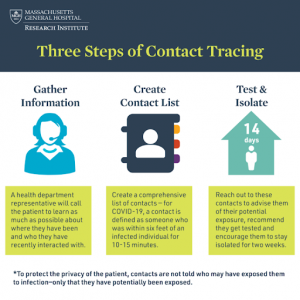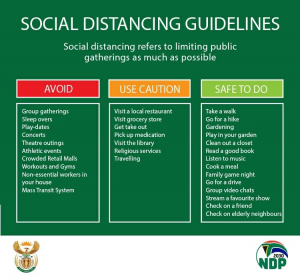
The Most Effective Way to Use Contact Tracing and Social Distancing to Enhance Safety and Confidence in the Workplace
Is it possible to be safe at your business premises amid the COVID-19 pandemic?
A report from the Johns Hopkins Center for Health Security revealed that the United States would need about 100,000 contact tracers to determine the contact between people infected with COVID-19 before it can reopen safely.
Most businesses are either reopening their offices, stores, and factories or preparing to do so. Therefore, business owners are expected to provide a safe environment, as well as tools that their employees can use to maintain social distancing rules and contact tracing mechanisms in the workplace.
With the rising number of coronavirus cases and deaths worldwide, more emphasis is placed on contact tracing and social distancing than ever before.
Human nature, which craves physical contact and proximity, especially during a conversation, makes social distancing look like a challenge. Nonetheless, keeping a distance of one and a half meters or six feet between yourself and anyone else in the office is a necessary protective measure.

Need additional peace of mind while working with other people?
Get a digital contact tracing tool. With this tool, you can keep yourself and your employees safe while working to increase the company’s sales and ROI. Such a tool usually comes with an app and a device to help track your movement and ensure you maintain a safe distance at work.
This article will address the value of contact tracing and social distancing, including the bad and ugly aspects. Basically, you will learn to –
- Understand the concept of contact tracing
- Understand the concept of social distancing
- The effect of COVID-19 on Workplace environments
- 3 proven ways to enforce workplace safety using digital tools
- 10 tips to minimize the exposure of people to COVID-19 in the workplace
- The way forward
Understanding the Concept of Contact Tracing
Marc Lipsitch, an epidemiologist at T.H. Chan School of Public Health at Harvard University, in an interview with STATnews said, “It’s clear that you can do a lot of control if you do contact tracing really well.”
But it takes everyday preventive measures to effectively slow down the spread of the virus. This is crucial until a vaccine or another treatment becomes readily available.
According to Gregory Poland, M.D. Mayo Clinic, the concept behind contact tracing is as simple as this:

If a person tests positive to COVID-19, the public health workers would want to know how many people they have been in contact with over the previous 14 days. This question is especially difficult to answer if a person had used a public vehicle and interacted with people in a public area.
They will then notify all the individuals that the person has potentially exposed to the virus. Also, they will try to find out how that person contracted the virus by back-tracing those a person was in contact with. To control further spread or outbreak of the disease, health workers will instruct these individuals to self-quarantine.
In a nutshell, here is how contact tracing helps to protect you:
- It informs people that they may have been exposed to the coronavirus;
- It helps people who get tested to know who have been infected and were not;
- It requests people who may have been in close contact with a coronavirus patient to self-quarantine and monitor their health;
- It asks people who have been tested positive to self-isolate;
Understanding the Concept of Social Distancing
Social distancing is also called physical distancing and refers to the practice of keeping a safe space between yourself and others. In practicing social distancing, you need to stay about 2 arms’ lengths (at least 6 feet) away from people, especially those who are not members of your household.

Social or physical distancing will go a long way in effectively reducing the spread of COVID-19 when practiced daily along with other preventive measures, such as wearing masks, washing your hands with soap and running water often, and not touching your face with unwashed hands.
The Effect of COVID-19 on Workplaces
The coronavirus pandemic may be an extended event if a vaccine is not made readily available to the public. Workplaces are definitely affected by this pandemic.
According to the Occupational Safety and Health Administration (OSHA), workplaces are likely to experience the following:
- Interruptions in supply and delivery: If your business depends on the shipment of goods from areas badly affected by the pandemic, there may be delays or cancellations. These may occur with or without notifying you and can lead to serious business setbacks.
- Absenteeism: Many factors could lead to workers being absent from work. When they are sick, afraid of risking exposure, or have to act as caregivers for sick or immunocompromised family members, they could be absent.
- Change in commerce patterns: The lockdown period saw a series of changes in commerce patterns. While there was an increase in the demand for products that could help to prevent infection (such as respirators, masks, gloves, and hand sanitizers), the textile industry experienced a decline in consumer interest.
There were also significant changes in shopping patterns, as many consumers preferred to shop during off-peak hours to limit contact with people. This, in turn, led to an increase in home deliveries and drive-through services.
3 Proven Ways to Reinforce Workplace Safety using Digital Tools
People are essential to the smooth operation of any business or industry. Without them, you won’t have a business to run. Therefore, their safety should be your priority so that they can work with confidence without putting you, themselves, customers, their families, and the general public at risk.
In light of the above, how can you reinforce workplace safety using contact tracing and social distancing?
- Enforce social distancing by introducing the smartspace Contact Tracing Technology
Do you see your employees as assets to your company? How do you show them you care about their well-being?
One of the best ways to care for your assets is by keeping them safe. Now that businesses are trying to get back on track and recover losses brought on by the lockdown, you need to implement a system that will allow you to enhance the confidence of people as they work to prevent your business from hitting the rocks.
Business owners and CEOs should enforce social distancing measures and contact tracing to allow people to work safely together.
Creating a digital monitoring system in line with EHSQ guidelines will also go a long way in empowering your employees. A digital contact tracing tool like smartspace will make it easier to enforce these social distancing policies while creating a new normal for workers.
- Monitor your team to ensure that they are keeping a safe distance from each other
The best way to ensure that your team members are following the social distancing rules in a controlled workplace is by equipping each of them with a portable wearable contact tracing tool.
This tool acts as a proximity sensor and is suitable for use in the office, healthcare facilities, construction sites, schools, manufacturing companies, and even retirement communities. They allow you to easily monitor interactions within a common area.
The sensors of the smartspace are triggered and set off either an audible or visible alarm when two or more people are closer to each other than the 6 feet safety limit. The administrator, who has the software installed on an android phone, is notified as well and can identify the persons involved.
- Keep track of all interactions between infected persons and healthy ones
It is important for CEOs, administrators, and business owners to closely monitor the potential spread of the virus in their local workplace facility. This level of contact tracing will make instant traceability easier since everyone in the facility will be wearing a digital tracking device.
The device works by sending data on potential contamination clusters back to the software, which is used to back-trace the movement of an infected employee. If the system back-traces contamination chains, employees at risk can be quarantined, and the premises can be clean again.
10 Tips to Minimize the Exposure of People to COVID-19 At Work
One of the best ways to limit your exposure, as well as that of your employees to COVID-19 is to implement safe work practices at work. This requires that you assess the risks before implementing the controls in hierarchies.
What this means is that you need to implement control measures that will eliminate the risks or minimize worker exposure. First, put collective measures in place, then where applicable, supplement them using individual measures.
These are some control measure examples that can apply to different workplaces or jobs:
- Only carry out essential work for now:
There are jobs you should postpone until the risk of contracting the virus is lower. As much as possible, try to limit the services you deliver in person. If you can, deliver some services remotely (either by phone or video).
Only the essential workers should be present at the physical office to reduce risk.
- Reduce physical contact between workers as much as possible:
Isolate your workers who can safely work alone without the need for machinery or specialized equipment, especially during meetings. They can work alone in a staff room or spare room.
If you have vulnerable workers like sick or older people among your staff, arrange for them to work from home. Workers who have high-risk family members should also telework.

- As much as you can, eliminate or limit physical interactions with customers
Manage the entry and make deliveries contactless, if possible, to either limit or eliminate interactions with and between customers. Avoid crowding outside your business premises, and ensure that customers abide by the physical distancing rules.
- Manage the delivery of goods
Whenever you are delivering goods, either use a pick-up or deliver the goods outside the premises. The cab drivers should maintain good hygiene, and you can also provide them with sanitation gels, wipes, and masks. Delivery workers should follow the appropriate sanitation protocols and precautions.
- Use impervious barriers between each worker
If you find it challenging to maintain a two-metre distance between your workers, place a purposely-made or improvised barrier between them. You can use plastic sheeting, storage units, partitions, or even mobile drawers to enforce this measure.
Avoid things that can cause tripping and falling as they pose a new risk of transmission. You can also create a space between workers by placing an empty desk or two between them.
- Reduce contact time
In cases where it is impossible to avoid close contact, keep contact between people to under 15 minutes. Also, organize your staff in such a way that will reduce contact between shifts.
Time the meal breaks be well to limit the number of people sharing the kitchen, cafeteria, or staff room. There should be one worker in the changing rooms and bathrooms at a time. You can place a sign to this effect on the main doors.
- Make soap, water, and hand sanitizers available
You should ensure that an endless supply of appropriate hand sanitizers, soap, and water are available at convenient spots. Then, advise your workers to maintain proper hygiene and wash their hands regularly. Clean your door handles, counters, tools, and other surfaces that people are prone to touch frequently. The office should also be well ventilated.
- Enforce proper hygiene of your workers to reduce the workload on your cleaning staff
Abiding by the guidelines of work practices takes its toll on the cleaning staff. To reduce this workload, ask your workers to keep their workplace neat and get extra staff to handle some of these tasks. Line waste bins with plastic bags so that staff do not come into contact with the contents when emptying them.
- Encourage workers to use individual transport instead of sharing transport
Make parking spaces available for cars and bicycles to reduce the risk of contact. Also, if possible, encourage your workers to walk instead of taking public transport to work.
- Be flexible regarding your leave policies
To encourage working remotely and reducing the presence of workers in the workplace, flexible leave policies should be established and provided when needed. Encourage workers to stay at home when they are sick.
Here is what you should do next once you’ve finished reading this article
As this article shows, employers have a big role to play in making the workplace safer. Workers no longer have to take unnecessary risks that threaten their safety with the introduction of SeguroLLC’s smartspace.
This latest technology from Silicon Valley triggers a warning when two workers are less than 6 feet apart. The instant device-to-device tracing works great for controlled work environments to create a new normal for workers in all industries.
Some of its primary benefits are as follows: It is lightweight, and compact, allowing real-time data downloads to the app, while it is easy to track by administrators, has a user-friendly dashboard, facilitates risk mitigation, and can last up to 10 days on a full charge.
Therefore, if you want your employees to be safe and confident at work, you need to equip them with this contact tracing and social distancing tool.

Sorry, the comment form is closed at this time.